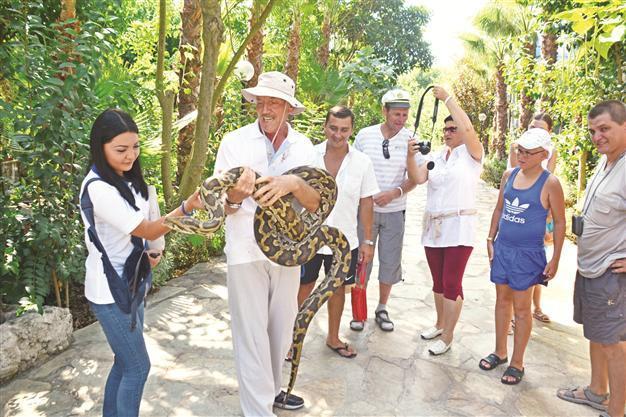Reptile tourism in Turkey's Antalya
ANTALYA - Anadolu Agency

Antalya’s Ecological National Park is a shelter for many plants and reptiles that are at risk of extinction. The park draws many tourists from all around the world, especially from Russia. DHA photo
Thousands of Russian tourists, who believe that touching snakes prevents sweaty palms, come to the Ecological National Park (Eko Park) in Tekirova in the southern province of Antalya’s Kemer district. The park draws around 40,000 to 50,000 visitors every year.
According to its website, Eko Park covers an area of 40,000 square meters and is the first flora and herpetofauna (plant, reptile and amphibian) park establishment.
Eko Park is a shelter for many plants and reptiles that are at risk of extinction, as people unaware of the vulnerable structure of nature destroy millions of micro- and thousands of macro-organisms.
The collection of reptiles in the park includes native poisonous and non-poisonous species of snakes, chameleons and other reptiles and amphibians, as well as exotic reptiles brought over from different parts of the world, such as pythons, coral snakes, boa constrictors, anacondas, vipers, cobras, mambas, timber rattlesnakes, giant lizards, turtles and crocodiles.
The founder of Eko Park, morphologist and herpetologist Selami Tomruk, said their goal in opening the park was to protect nature from being looted and to introduce the importance of wild life. He said animals seized in zoos had lost their wild instinct, so they wanted to create an “ecologic park” instead.
Rare speciesTomruk said Eko Park was home to many species that were rarely seen in the wild such as anacondas, spitting snakes, black mambas and alligators. “People come, particularly from Russia, just to touch the snakes. Russians believe their palms won’t sweat if they touch a snake. Some Russians come to the park only to do this.”
He added that as well as Russians, the park also drew lots of tourists from Ukraine, Azerbaijan, Poland, the Czech Republic, Hungary and Germany. “We don’t host too many Turkish visitors and we want to see them more,” he said.
He said the Eko Park also drew a lot of attention from universities from all around the world. Many university students are visiting the park and writing their theses, Tomruk stated, while also noting that he did not see any Turkish university students in the park.
“Some tourists come to the park at night and work on scorpions with thermal cameras. They share their research with university students in their own country. For example, Russian television stations and newspapers conducted research here to examine the role of snakes on palm sweating. This place does not have a touristic aim, but rather a scientific aim. I wish we could establish a scientific institute here,” he said.
